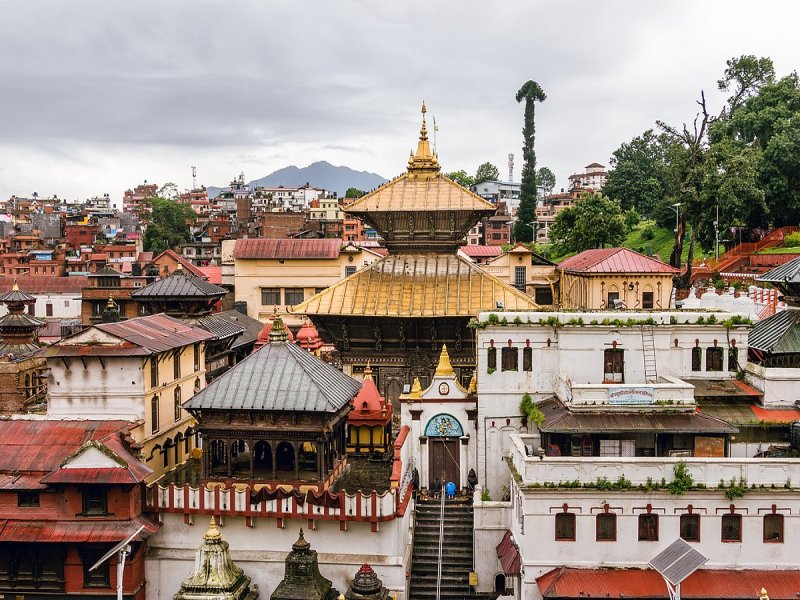Pashupatinath Temple, an epitome of sacredness and architectural brilliance, stands majestically on the banks of the Bagmati River in Kathmandu, Nepal. As one of the most revered temples dedicated to Lord Shiva, Pashupatinath attracts millions of devotees and tourists annually. This iconic site is not only a spiritual center but also a significant tourism hub that showcases the rich cultural and religious heritage of Nepal.
Pashupatinath’s history dates back to the 5th century, although the origins of the temple are believed to be even older. The temple complex, which is a UNESCO World Heritage Site, is adorned with intricate carvings, pagoda-style architecture, and sacred shrines. The main temple houses a unique four-faced Shiva Lingam, symbolizing Lord Shiva’s omnipresence in all directions. The grandeur of the temple and its profound spiritual aura have made it a vital pilgrimage site for Hindus worldwide.
Visiting Pashupatinath offers an immersive cultural and spiritual experience. The temple complex is bustling with activities, from daily rituals and ceremonies to grand festivals. Devotees can witness the vibrant aarti (ritual of worship) performed every evening, accompanied by the enchanting sounds of bells and chants. The atmosphere is filled with devotion, reverence, and a sense of tranquility that captivates both pilgrims and tourists.
This year, Pashupatinath is hosting the grand Kotihom, a month-long spiritual event that commenced on Shrawan 1st and will conclude on Shrawan’s last day. Kotihom is a significant Vedic ritual aimed at invoking divine blessings, peace, and prosperity. The event involves continuous recitations of Vedic hymns, elaborate fire rituals, and offerings to Lord Shiva. Thousands of devotees and priests participate in this sacred event, creating an atmosphere of heightened spirituality and devotion.
Pashupatinath’s appeal extends beyond its religious significance. The temple’s strategic location in Kathmandu makes it easily accessible to tourists. Tribhuvan International Airport is just a short drive away, and various transportation options, including taxis and buses, connect the temple to other parts of the city. The temple’s proximity to popular tourist spots such as Boudhanath Stupa and Swayambhunath (Monkey Temple) further enhances its appeal to visitors.
The area around Pashupatinath is replete with attractions that offer a glimpse into Nepal’s cultural and natural beauty. The Bagmati River, flowing beside the temple, holds spiritual significance and is considered holy by Hindus. Tourists can witness the traditional cremation ceremonies along the riverbanks, providing a profound understanding of Nepalese customs and beliefs about life and death.
The nearby Arya Ghat is a revered site for performing last rites and rituals. The ghats (steps leading down to the river) are an integral part of the temple complex and offer a serene ambiance for reflection and prayer.
Pashupatinath’s prominence as a religious and tourist destination significantly contributes to the local economy. The influx of tourists and pilgrims creates numerous opportunities for local businesses, including hotels, restaurants, and souvenir shops. The sale of religious artifacts, traditional handicrafts, and locally produced goods provides livelihoods for many residents. The temple also generates employment for priests, guides, and support staff, further boosting the local economy.
Given its historical and cultural importance, preserving Pashupatinath and its surroundings is crucial. The Pashupati Area Development Trust (PADT) is actively involved in the conservation and management of the temple complex. Efforts include maintaining architectural integrity, ensuring cleanliness, and promoting sustainable tourism practices. The trust also organizes awareness programs to educate visitors about the temple’s significance and the need for respectful behavior.
Pashupatinath is a cornerstone of pilgrimage tourism in Nepal. Pilgrims from India, Nepal, and other countries flock to the temple during auspicious occasions such as Maha Shivaratri, Teej, and the month of Shrawan. These festivals witness a surge in the number of devotees, turning the temple into a vibrant hub of religious fervor. The rituals, fasting, and devotional songs create a unique cultural experience for both pilgrims and tourists.
The lush green surroundings of Pashupatinath offer ample opportunities for ecotourism. The temple is located near the Shivapuri Nagarjun National Park, which is home to diverse flora and fauna. Tourists can explore nature trails, enjoy birdwatching, and experience the tranquility of the forest. The park also offers panoramic views of the Kathmandu Valley, making it a perfect retreat for nature enthusiasts.
To ensure the longevity of Pashupatinath’s heritage and the well-being of the local community, adopting sustainable tourism practices is essential. Responsible tourism initiatives such as waste management, minimizing environmental impact, and promoting local culture can enhance the visitor experience while preserving the site’s sanctity. Collaboration between the government, local authorities, and tourism stakeholders is vital in achieving these goals.
Pashupatinath Temple, with its profound spiritual significance and cultural heritage, stands as a testament to Nepal’s rich traditions. The temple’s allure extends beyond its religious importance, making it a sought-after destination for tourists seeking a blend of spirituality, culture, and history. The ongoing grand Kotihom adds a unique dimension to the temple’s vibrancy, attracting devotees and tourists alike. As efforts to preserve and promote this iconic site continue, Pashupatinath will undoubtedly remain a beacon of divine grace and a cornerstone of Nepalese tourism.






